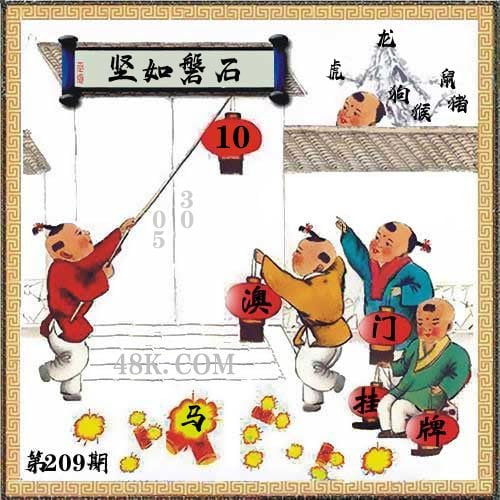澳门六合彩【挂牌】 更多»

|
209期 | |
|---|---|---|
| 挂牌 | 10 | |
| 火烧 | 马 | |
| 横批 | 坚如磐石 | |
| 门数 | 05,03 | |
| 六肖 | 龙虎鼠狗猪猴 | |
澳门挂牌解析
2024-209期正版彩图挂:10;挂牌:坚如磐石;六肖:龙虎鼠狗猪猴;火烧:马
解析:【出自】:《玉台新咏 古诗为焦仲卿作》:“君当作磐石,妾当作蒲苇。蒲苇纫如丝,磐石无转移。”【示例】:我们伟大的祖国坚如磐石。
解释:坚:牢固;磐石:大石头。牢固得像大石头一样。形容非常坚固;不可动摇。
综合取肖:蛇牛虎羊猴狗
解析:【出自】:《玉台新咏 古诗为焦仲卿作》:“君当作磐石,妾当作蒲苇。蒲苇纫如丝,磐石无转移。”【示例】:我们伟大的祖国坚如磐石。
解释:坚:牢固;磐石:大石头。牢固得像大石头一样。形容非常坚固;不可动摇。
综合取肖:蛇牛虎羊猴狗
【正版澳彩图库】 更多»
澳门管家婆100282.com
『成语平特』
209期
成语爆平特
【洋洋得意】
开
¥00
准
206期
成语爆平特
【马到成功】
开
马11
准
204期
成语爆平特
【虎虎生威】
开
虎37
准
200期
成语爆平特
【龙飞九天】
开
龙49
准
198期
成语爆平特
【马到成功】
开
马23
准
澳门管家婆100282.com
『欲钱解特』
209期:
欲钱解特诗
开:¥00
《鼠猪虎羊发大财,本期特码出大数》
208期:
欲钱解特诗
开:牛04
《羊龙鼠猴发大财,本期特码出小数》
207期:
欲钱解特诗
开:猪18
《蛇羊虎猪发大财,本期特码出小数》
205期:
欲钱解特诗
开:牛40
《兔虎羊鸡发大财,本期特码出大数》
203期:
欲钱解特诗
开:猴45
《牛蛇鸡猪发大财,本期特码出大数》
澳彩图库心水图片资料专区
澳彩独家高手出版精料
澳彩综合全年资料大全
澳彩资料独家精准四肖
| 209期: ⑨肖 | 龙猴猪狗鸡羊牛马鼠 | ????中 |
| 209期: ⑧肖 | 龙猴猪狗鸡羊牛马 | ????中 |
| 209期: ⑦肖 | 龙猴猪狗鸡羊牛 | ????中 |
| 209期: ⑥肖 | 龙猴猪狗鸡羊 | ????中 |
| 209期: ⑤肖 | 龙猴猪狗鸡 | ????中 |
| 209期: ④肖 | 龙猴猪狗 | ????中 |
| 208期--长期跟踪,稳赚不赔! | ||
| 208期: ⑨肖 | 牛马蛇鸡龙狗羊虎猴 | 牛04中 |
| 208期: ⑧肖 | 牛马蛇鸡龙狗羊虎 | 牛04中 |
| 208期: ⑦肖 | 牛马蛇鸡龙狗羊 | 牛04中 |
| 208期: ⑥肖 | 牛马蛇鸡龙狗 | 牛04中 |
| 208期: ⑤肖 | 牛马蛇鸡龙 | 牛04中 |
| 208期: ④肖 | 牛马蛇鸡 | 牛04中 |
| 207期--长期跟踪,稳赚不赔! | ||
| 207期: ⑨肖 | 猪狗马龙蛇鸡牛兔虎 | 猪18中 |
| 207期: ⑧肖 | 猪狗马龙蛇鸡牛兔 | 猪18中 |
| 207期: ⑦肖 | 猪狗马龙蛇鸡牛 | 猪18中 |
| 207期: ⑥肖 | 猪狗马龙蛇鸡 | 猪18中 |
| 207期: ⑤肖 | 猪狗马龙蛇 | 猪18中 |
| 207期: ④肖 | 猪狗马龙 | 猪18中 |
| 206期--长期跟踪,稳赚不赔! | ||
| 206期: ⑨肖 | 蛇羊牛兔鸡虎猪鼠狗 | 兔14中 |
| 206期: ⑧肖 | 蛇羊牛兔鸡虎猪鼠 | 兔14中 |
| 206期: ⑦肖 | 蛇羊牛兔鸡虎猪 | 兔14中 |
| 206期: ⑥肖 | 蛇羊牛兔鸡虎 | 兔14中 |
| 206期: ⑤肖 | 蛇羊牛兔鸡 | 兔14中 |
| 206期: ④肖 | 蛇羊牛兔 | 兔14中 |
| 205期--长期跟踪,稳赚不赔! | ||
| 205期: ⑨肖 | 兔蛇马猪狗龙羊鸡牛 | 牛40中 |
| 205期: ⑧肖 | 兔蛇马猪狗龙羊鸡 | 牛40中 |
| 205期: ⑦肖 | 兔蛇马猪狗龙羊 | 牛40中 |
| 205期: ⑥肖 | 兔蛇马猪狗龙 | 牛40中 |
| 205期: ⑤肖 | 兔蛇马猪狗 | 牛40中 |
| 205期: ④肖 | 兔蛇马猪 | 牛40中 |
| 204期--长期跟踪,稳赚不赔! | ||
| 204期: ⑨肖 | 鼠狗牛猪龙鸡马蛇猴 | 鼠05中 |
| 204期: ⑧肖 | 鼠狗牛猪龙鸡马蛇 | 鼠05中 |
| 204期: ⑦肖 | 鼠狗牛猪龙鸡马 | 鼠05中 |
| 204期: ⑥肖 | 鼠狗牛猪龙鸡 | 鼠05中 |
| 204期: ⑤肖 | 鼠狗牛猪龙 | 鼠05中 |
| 204期: ④肖 | 鼠狗牛猪 | 鼠05中 |
| 203期--长期跟踪,稳赚不赔! | ||
| 203期: ⑨肖 | 猪马牛龙猴狗鸡羊兔 | 猴45中 |
| 203期: ⑧肖 | 猪马牛龙猴狗鸡羊 | 猴45中 |
| 203期: ⑦肖 | 猪马牛龙猴狗鸡 | 猴45中 |
| 203期: ⑥肖 | 猪马牛龙猴狗 | 猴45中 |
| 203期: ⑤肖 | 猪马牛龙猴 | 猴45中 |
| 203期: ④肖 | 猪马牛龙 | 猴45中 |






